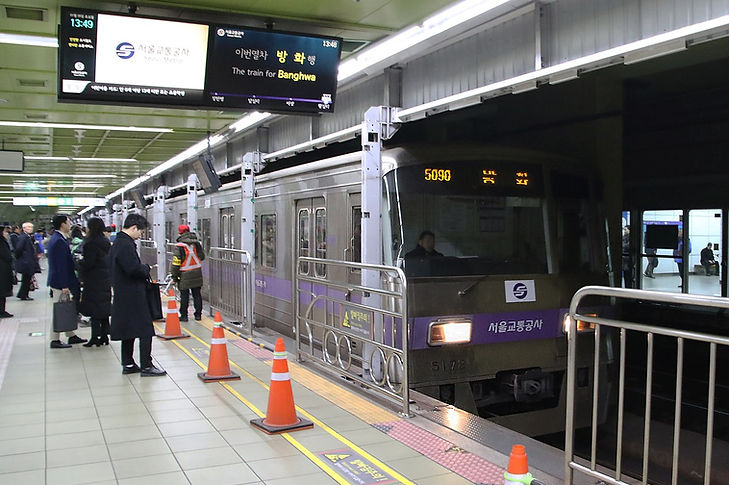Line 5
Seoul Metro 5000-series
Before reading this section, it is recommended to read the "Brief Intro to Numbering" section on the Trains page.
First Generation
The first generation of Seoul Metro 5000-series trains were built from 1994 to 1997 by Hyundai Precision. 76 trains were built, numbered 5-01~5-76.
The overall exterior design is similar to the Seoul Metro 4000-series, Seoul Metro 1000-series, and Korail 3000-series. Compared to those trains, these trains have a noticeably rounder (or smoother) design. In the interior, LED display screens were put on the sides of the car, above the doors.
These trains came standard with TCMS and ATO.
Trains 5-01~5-46 feature slightly smaller LED destination signs than 5-47~5-76. Trains 5-22~5-76 feature polished sides.
All trains were delivered with a VVVF-GTO propulsion system from ABB.

All trains are eight cars long. The car numbering is as follows:
50XX-Tc (Leading car with cab, SIV, battery)
57XX-M (Air compressor, main converter, inverter, controller)
56XX-M' (Pantograph, main controller, inverter, peripheral pressure and exchange device)
55XX-T (Unpowered car)
54XX-T
53XX-M
52XX-M'
51XX-Tc

Train 5-72. Note the larger LED destination sign.
By Mtattrain - Own work, CC BY-SA 4.0, https://commons.wikimedia.org/w/index.php?curid=75593755
All trains were refurbished with fire-resistant interiors in 2006. The windows were also double-glazed, as opposed to single.
In 2010, all trains had their interior LED signs replaced with two LCD monitors per door. Cushions were installed on the bottom of the seats.
In 2011, train 5-02 was retrofitted with a Dawonsys VVVF-IGBT unit after mechanical problems with the original system. (Video linked has a comparison with the original units)
Train 5-18 was retired in 2017 due to mechanical issues and defects with its wheel bogies. Said train derailed at Balsan Station on May 24, 2020, while being transferred from Goedeok to Banghwa. The damage was severe enough that the entire train will be scrapped.
Train 5-29 suffered fire damage that resulted in car 5029 being written off. It was replaced with car 5018.
With all stations on Line 5 featuring screen doors, the side destination signs on all trains have been covered up.
The rest of the trains remain in service today. Trains 5-01~5-38 are stored at the Godeok Depot, while 5-39~5-76 are stored at Banghwa.
Second Generation
The second generation was built from 2017 to 2018 by Hyundai Rotem. Four trains were built, numbered 5-77~5-80. All are eight cars long.
The design of these trains are based on the Seoul Metro 9000-series trains. Its propulsion system seems to be the same Hyundai Rotem VVVF-IGBT (IPM) unit used on the fourth generation Seoul Metro 2000-series trains.
These trains are currently undergoing commissioning, due to enter service when the Hanam Line is open.
These trains are stored at the Godeok Depot.

A second generation train, number unknown.
By Myeongho jeong - Own work, CC BY-SA 4.0, https://commons.wikimedia.org/w/index.php?curid=70627249
Third Generation
A third generation will be built by Woojin. 25 trains will be built.
A vote on several concept designs were taken at Yeouido Station in September 2019. The design of these trains would be shared with new trains on Line 7 (and maybe Line 8). Eventually, the final design was confirmed to be interior concept 2 and exterior concept 2.
The propulsion system will be a Toshiba VVVF-IGBT (PMSM) unit. It will be the same unit currently used on the second generation trains running on Busan Metro Line 1.
Back to Trains
Back to History
Back to Seoul Metro